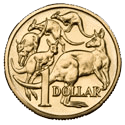Australian dollar
| Australian dollar | |||||
|---|---|---|---|---|---|
| Australian dollar (English) | |||||
| |||||
| ISO 4217 | |||||
| Code | AUD | ||||
| Number | 036 | ||||
| Exponent | 2 | ||||
| Denominations | |||||
| Subunit | |||||
| 1/100 | cent | ||||
| Symbol | $, A$ or AUD | ||||
| cent | c | ||||
| Banknotes | |||||
| Freq. used | $5, $10, $20, $50, $100 | ||||
| Coins | 5c, 10c, 20c, 50c, $1, $2 | ||||
| Demographics | |||||
| Date of introduction | 14 February 1966 | ||||
| Replaced | Australian pound | ||||
| Official user(s) |
7 Australian territories
5 other countries
| ||||
| Unofficial user(s) |
| ||||
| Issuance | |||||
| Central bank | Reserve Bank of Australia | ||||
| Website |
www | ||||
| Printer | Note Printing Australia | ||||
| Website |
www | ||||
| Mint | Royal Australian Mint | ||||
| Website |
www | ||||
| Valuation | |||||
| Inflation | 1.8% (Australia only) | ||||
| Source | Reserve Bank of Australia, September 2018. | ||||
| Pegged by | Tuvaluan dollar and Kiribati dollar at par | ||||
The Australian dollar (sign: $; code: AUD) is the currency of the Commonwealth of Australia, including its external territories Christmas Island, Cocos (Keeling) Islands, and Norfolk Island, as well as the independent Pacific Island states of Kiribati, Nauru, Tonga, Tuvalu, and Vanuatu. The Australian dollar was legal tender of Papua New Guinea until 1 January 1976, when the Papua New Guinean kina became the sole legal tender. Within Australia, it is almost always abbreviated with the dollar sign ($), with A$ or AU$ sometimes used to distinguish it from other dollar-denominated currencies.[2][3] It is subdivided into 100 cents.
In 2016, the Australian dollar was the fifth most traded currency in the world, accounting for 6.9% of the world's daily share (down from 8.6% in 2013).[4] It trades in the world foreign exchange markets behind the US dollar, the euro, the yen and the pound sterling.[5] The Australian dollar is popular with currency traders, because of the comparatively high interest rates in Australia, the relative freedom of the foreign exchange market from government intervention, the general stability of Australia's economy and political system, and the prevailing view that the Australian dollar offers diversification benefits in a portfolio containing the major world currencies, especially because of its greater exposure to Asian economies and the commodities cycle.[6] The currency is commonly referred to by foreign-exchange traders as the "Aussie dollar".
History
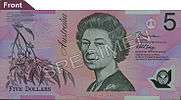

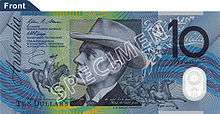
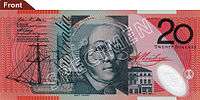
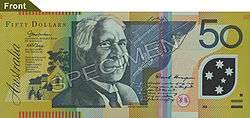
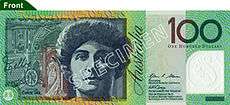
With pounds, shillings and pence to be replaced by decimal currency on 14 February 1966, many names for the new currency were suggested. In 1963, Prime Minister, Sir Robert Menzies, a monarchist, wished to name the currency the royal. Other proposed names from a public naming competition included more exotic suggestions such as the austral, the oz, the boomer, the roo, the kanga, the emu, the koala, the digger, the zac, the kwid, the dinkum, and the ming (Menzies' nickname). Menzies' influence resulted in the selection of the royal, and trial designs were prepared and printed by the Reserve Bank of Australia. Australian treasurer and future Prime Minister, Harold Holt, announced the decision in Parliament on 5 June 1963. The royal would be subdivided into 100 cents, but the existing names shilling, florin and crown would be retained for the 10-cent, 20-cent and 50-cent coins respectively. The name royal for the currency proved very unpopular, with Holt and his wife even receiving death threats.[7] On 24 July Holt told the Cabinet the decision had been a "terrible mistake" and it would need to be revisited. On 18 September Holt advised Parliament that the name was to be the dollar, of 100 cents.[8][9]
The Australian pound, introduced in 1910 and officially distinct in value from the pound sterling since devaluation in 1931,[10] was replaced by the dollar on 14 February 1966.[11] The rate of conversion for the new decimal currency was two dollars per Australian pound, or ten Australian shillings per dollar. The exchange rate was pegged to the pound sterling at a rate of $1 = 8 shillings ($2.50 = UK £1). In 1967, Australia effectively left the sterling area, when the pound sterling was devalued against the US dollar and the Australian dollar did not follow. It maintained its peg to the US dollar at the rate of A$1 = US$1.12.
On 27 September 2012, the Reserve Bank of Australia stated that it had ordered work on a project to upgrade the current banknotes. The upgraded banknotes would incorporate a number of new future proof security features[12] and include Braille dots for ease of use of the visually impaired. The first new banknotes (of the five dollar denomination) were issued from 1 September 2016, with the remaining denominations to be issued in the coming years.[13]
Coins
In 1966, coins were introduced in denominations of 1, 2, 5, 10, 20 and 50 cents. The initial 50-cent coins contained 80% silver and were withdrawn after a year when the intrinsic value of the silver content was found to considerably exceed the face value of the coins. One-dollar coins were introduced in 1984, followed by two-dollar coins in 1988 to replace the banknotes of that value, while the one- and two-cent coins were discontinued in 1991 and withdrawn from circulation. In commemoration of the 40th anniversary of decimal currency, the 2006 mint proof and uncirculated sets included one- and two-cent coins. In early 2013, Australia's first triangular coin was introduced to mark the 25th anniversary of the opening of Parliament House. The silver $5 coin is 99.9% silver, and depicts Parliament House as viewed from one of its courtyards.[14] Cash transactions are rounded to the nearest five cents. As with most public changes to currency systems, there has been a great amount of seignorage of the discontinued coins. All coins portray the reigning Australian Sovereign, Queen Elizabeth II, on the obverse, and are produced by the Royal Australian Mint.
Australia has regularly issued commemorative 50-cent coins. The first was in 1970, commemorating James Cook's exploration along the east coast of the Australian continent, followed in 1977 by a coin for Queen Elizabeth II's Silver Jubilee, the wedding of Charles, Prince of Wales and Lady Diana Spencer in 1981, the Brisbane Commonwealth Games in 1982, and the Australian Bicentenary in 1988. Issues expanded into greater numbers in the 1990s and the 21st century, responding to collector demand. Australia has also made special issues of 20-cent, one-dollar and two-dollar coins.
Current Australian 5-, 10- and 20-cent coins are identical in size to the former Australian, New Zealand, and British sixpence, shilling, and two shilling (florin) coins. Australia is the last Commonwealth country where pre-decimal sixpences, shillings and florins, while now rare, may still be found in circulation. In 1990 and 1993, the UK replaced these coins with smaller versions, as did New Zealand in 2006 – at the same time discontinuing the five-cent coin. With a mass of 15.55 grams (0.549 oz) and a diameter of 31.51 millimetres (1 1⁄4 in), the Australian 50-cent coin is one of the largest coins used in the world today. In circulation, the old New Zealand 5-, 10- and 20-cent coins were often mistaken for Australian coins of the same value, owing to their identical size and shape. Until the size of the New Zealand coins was changed in 2004, Australian coins below the dollar in value were in circulation in both countries. Still, some confusion occurs with the larger-denomination coins in the two countries; Australia's $1 coin is similar in size to New Zealand's $2 coin, and the New Zealand $1 coin is similar in size to Australia's $2 coin. As a result, Australian coins are occasionally found in New Zealand and vice versa.
Banknotes
First series
The first paper issues of the Australian dollar were issued in 1966. The $1, $2, $10 and $20 notes had exact equivalents in the former pound banknotes. The $5 note was issued in 1967, the $50 note was issued in 1973 and the $100 was issued in 1984.[15]
First polymer series
The first polymer banknotes were issued in 1988[16] by the Reserve Bank of Australia, specifically polypropylene polymer banknotes (produced by Note Printing Australia), to commemorate the bicentenary of European settlement in Australia. All Australian notes are now made of polymer. Australia was the first country to develop and use polymer banknotes.
Second Polymer series
A new series of banknotes is being introduced, starting with the $5 note from 1 September 2016.[17] A new $10 banknote has been released into circulation from 20 September 2017.[18] A new $50 note will be released into circulation on 18 October 2018.
Value
| Rank | Currency | ISO 4217 code (symbol) | % daily share (April 2016) |
|---|---|---|---|
1 | USD (US$) | 87.6% | |
2 | EUR (€) | 31.4% | |
3 | JPY (¥) | 21.6% | |
4 | GBP (£) | 12.8% | |
5 | AUD (A$) | 6.9% | |
6 | CAD (C$) | 5.1% | |
7 | CHF (Fr) | 4.8% | |
8 | CNY (元) | 4.0% | |
9 | SEK (kr) | 2.2% | |
10 | NZD (NZ$) | 2.1% | |
11 | MXN ($) | 1.9% | |
12 | SGD (S$) | 1.8% | |
13 | HKD (HK$) | 1.7% | |
14 | NOK (kr) | 1.7% | |
15 | KRW (₩) | 1.7% | |
16 | TRY (₺) | 1.4% | |
17 | RUB (₽) | 1.1% | |
18 | INR (₹) | 1.1% | |
19 | BRL (R$) | 1.0% | |
20 | ZAR (R) | 1.0% | |
| Other | 7.1% | ||
| Total[19] | 200.0% | ||

In 1966, when the dollar was introduced, the international currency relationships were maintained under the Bretton Woods system, a fixed exchange rate system using a U.S. dollar standard. The Australian dollar, however, was effectively pegged to the British pound at an equivalent value of approximately 1 gram of gold.
The highest valuation of the Australian dollar relative to the U.S. dollar was during the period of the peg to the U.S. dollar. On 9 September 1973, the peg was adjusted to US$1.4875, the fluctuation limits being changed to US$1.485–US$1.490;[20] on both 7 December 1973 and 10 December 1973, the noon buying rate in New York City for cable transfers payable in foreign currencies reached its highest point of 1.4885 U.S. dollars to one dollar.[21]
On 12 December 1983, the dollar was floated, allowing its value to fluctuate dependent on supply and demand on international money markets. The decision was made on 8 December 1983 and announced on 9 December 1983.[22]
In the two decades that followed, its highest value relative to the US dollar was $0.881 in December 1988. The lowest ever value of the dollar after it was floated was 47.75 US cents in April 2001.[23] It returned to above 96 US cents in June 2008,[24] and reached 98.49 later that year. Although the value of the dollar fell significantly from this high towards the end of 2008, it gradually recovered in 2009 to 94 US cents.
On 15 October 2010, the dollar reached parity with the US dollar for the first time since becoming a freely traded currency, trading above US$1 for a few seconds.[25] The currency then traded above parity for a sustained period of several days in November, and fluctuated around that mark into 2011.[26] On 27 July 2011, the dollar hit a record high since floating. It traded at a $1.1080 against the US dollar.[27]
Some commentators speculated that the value of the dollar in 2011 was related to Europe's sovereign debt crisis, and Australia's strong ties with material importers in Asia and in particular China.[28]
Economists posit that commodity prices are the dominant driver of the Australian dollar, and this means changes in exchange rates of the Australian dollar occur in ways opposite to many other currencies.[29] For decades, Australia's balance of trade has depended primarily upon commodity exports such as minerals and agricultural products. This means the Australian dollar varies significantly during the business cycle, rallying during global booms as Australia exports raw materials, and falling during recessions as mineral prices slump or when domestic spending overshadows the export earnings outlook. This movement is in the opposite direction to other reserve currencies, which tend to be stronger during market slumps as traders move value from falling stocks into cash.
The Australian dollar is a reserve currency and one of the most traded currencies in the world.[6] Other factors in its popularity include a relative lack of central bank intervention, and general stability of the Australian economy and government.[30] In January 2011 at the World Economic Forum in Davos, Switzerland, Alexey Ulyukaev announced that the Central Bank of Russia would begin keeping Australian dollar reserves.[31]
Exchange rate policies
Prior to 1983, Australia maintained a fixed exchange rate. The first peg was between the Australian and British pounds, initially at par, and later at 0.8 GBP (16 shillings sterling). This reflected its historical ties as well as a view about the stability in value of the British pound. From 1946 to 1971, Australia maintained a peg under the Bretton Woods system, a fixed exchange rate system that pegged the U.S. dollar to gold, but the Australian dollar was effectively pegged to sterling until 1967.
With the breakdown of the Bretton Woods system in 1971, Australia converted the traditional peg to a fluctuating rate against the US dollar. In September 1974, Australia valued the dollar against a basket of currencies called the trade weighted index (TWI) in an effort to reduce the fluctuations associated with its tie to the US dollar.[32] The daily TWI valuation was changed in November 1976 to a periodically adjusted valuation.
On 12 December 1983, the Australian Labor government led by Prime Minister Bob Hawke and Treasurer Paul Keating floated the dollar, with the exchange rate reflecting the balance of payments and other market drivers.
Legal tender
Australian banknotes are a legal tender throughout the Commonwealth of Australia and its territories, as provided in section 36(1) of the Reserve Bank Act 1959.
For legal tender of Australian coinage, as outlined in section 16 of the Currency Act 1965, the following limits are set out:[33]
- 5c, 10c, 20c, and 50c (of any combination): for payments not exceeding $5
- 1c and 2c coins (which have been withdrawn from circulation): for payments not exceeding 20 cents
- One dollar and two dollar coins: for payments not exceeding 10 times the face value of a coin of the denomination concerned
- Non-circulating ten dollar coins: for payments not exceeding $100
- Coins of other denominations: for payments of any amount
Design and denominations
Australia was the first country in the world to have a complete system of banknotes made from plastic (polymer). These notes provide much greater security against counterfeiting. The polymer notes are cleaner than paper notes, are more durable and easily recyclable.
Australia's currency comprises coins of 5, 10, 20 and 50 cent and one and two dollar denominations; and notes of 5, 10, 20, 50 and 100 dollar denominations.
Many forms of currency were used in the Australian colonies after the arrival of the first European settlers in 1788. In the rough early conditions barter was necessary, and payment in commodities like rum sometimes replaced money in transactions. Some of the first official notes used in Australia were Police Fund Notes, issued by the Bank of New South Wales in 1816.
After 1901, when the Australian colonies federated into a single Commonwealth, the federal government became responsible for the currency. The Bank Notes Tax Act 1910 effectively brought private and state currencies to an end. In 1913 the first series of Australian notes was issued, based on the old British system of 12 pence to a shilling, 20 shillings to a pound.
In 1963, Australia initiated the change to decimal currency. More than 1000 submissions were made about the name of the new currency unit. The Prime Minister of the day, Sir Robert Menzies, proposed the 'royal'. The 'dollar' was eventually chosen as the name, and decimal currency was introduced on 14 February 1966.
Shortly after the changeover, substantial counterfeiting of $10 notes was detected. This provided an impetus for the Reserve Bank of Australia to develop new note technologies jointly with the Commonwealth Scientific and Industrial Research Organisation.
The revolutionary polymer notes were first introduced in 1988 with the issue of a commemorative $10 note,[34] marking Australia's bicentenary by featuring the theme of settlement. The note depicted on one side a young male Aboriginal person in body paint, with other elements of Aboriginal culture. On the reverse side was the ship Supply from the First Fleet, with a background of Sydney Cove, as well as a group of people to illustrate the diverse backgrounds from which Australia has evolved over 200 years.
- The $100 note features world-renowned soprano Dame Nellie Melba (1861–1931), and the distinguished soldier, engineer and administrator General Sir John Monash (1865–1931).[35]
- The $50 note features Aboriginal writer and inventor David Unaipon (1872–1967), and Australia's first female parliamentarian, Edith Cowan (1861–1932).[36]
- The $20 note features the founder of the world's first aerial medical service (the Royal Flying Doctor Service of Australia), the Reverend John Flynn (1880–1951), and Mary Reibey (1777–1855), who arrived in Australia as a convict in 1792 and went on to become a successful shipping magnate and philanthropist.[37]
- The $10 note features the poets AB "Banjo" Paterson (1864–1941) and Dame Mary Gilmore (1865–1962). This note incorporates micro-printed excerpts of Paterson's and Gilmore's work.[38] On 17 February, the Reserve Bank revealed the design of the new $10 banknote[39].
- The $5 note features Her Majesty Queen Elizabeth II and Parliament House, Canberra, the national capital. (Note that a special centenary issue of the $5 note featured Sir Henry Parkes and Catherine Helen Spence in 2001.)[40] In 2015-2016 there was a petition to feature Fred Hollows on a new $5 note, the outcome of this campaign is yet to be announced.[41] On 11 February 2016 it was announced that on 1 September 2016 a new $5 banknote would be released featuring a depiction of native Australian wattle and bird. On 12 April, the design of the new $5 banknote was released.[42][43]
Polymer note technology was developed by Australia, and Australia prints polymer banknotes for a number of other countries. In 1988, Australia introduced its first polymer bank note and in 1996, Australia became the first country in the world to have a complete series of polymer notes. Australia's notes are printed by Note Printing Australia, a wholly owned subsidiary of the Reserve Bank of Australia. Note Printing Australia prints polymer notes or simply supplies the polymer substrate[44] for a growing number of other countries including Bangladesh, Brunei, Chile, Indonesia, Kuwait, Malaysia, Mexico, Nepal, New Zealand, Papua New Guinea, Romania, Samoa, Singapore, Solomon Islands, Sri Lanka, Thailand and Vietnam. Many other countries are showing a strong interest in the new technology.
All Australian coins depict Queen Elizabeth II on the obverse, with different images on the reverse of each coin.
- The $2 coin, which replaced the paper two dollar note in 1988, depicts an Aboriginal tribal elder set against a background of the Southern Cross and native grasstrees. (Designed by Horst Hahne)
- The $1 coin, which replaced the paper $1 note in 1984, depicts five kangaroos. (Designed by Stuart Devlin)
- The 50 cent coin carries the coat of arms of Australia: the six state badges on a central shield supported by a kangaroo and an emu, with a background of golden wattle, Australia's floral emblem (Designed by Stuart Devlin)
- The 20 cent coin carries a platypus, one of only two egg-laying mammals in the world. It has webbed feet and a duck-like bill that it uses to hunt for food along the bottom of streams and rivers. (Designed by Stuart Devlin)
- The 10 cent coin features a male lyrebird dancing. A clever mimic, the lyrebird inhabits the dense, damp forests of Australia's eastern coast. (Designed by Stuart Devlin)
- The 5 cent coin depicts an echidna, or spiny anteater, the world's only other egg-laying mammal. (Designed by Stuart Devlin)
- The 2 cent coin (withdrawn from circulation since 1992) depicted a frilled lizard. (Designed by Stuart Devlin)
- The 1 cent coin (withdrawn from circulation since 1992) depicted a feather tailed glider (Designed by Stuart Devlin)
The 5, 10, 20 and 50 cent coins are made of cupronickel (75 percent copper and 25 percent nickel). The one and two dollar coins are made of aluminium bronze (92 percent copper, 6 per cent aluminium and 2 per cent nickel). The two dollar, one dollar, 50 and 20 cent circulating coins occasionally feature commemorative designs.
Australia's coins are produced by the Royal Australian Mint, which is located in the nation's capital, Canberra. Since opening in 1965, the Mint has produced more than 14 billion circulating coins, and has the capacity to produce more than two million coins per day, or more than 600 million coins per year. The Royal Australian Mint has an international reputation for producing quality numismatic coins, and won an international award for 'Best Silver Coin 2006' for its Silver Kangaroo coin design.
Australian currency tactile feature
In early 2015 the Reserve Bank of Australia announced that a tactile feature will be added to all new notes.[45] The tactile feature is an embossed feature to assist the vision-impaired in identifying the denomination. A similar feature is used on the Canadian currency.[46]
Current exchange rates
| Current AUD exchange rates | |
|---|---|
| From Google Finance: | CAD CHF EUR GBP HKD JPY USD CNY INR |
| From Yahoo! Finance: | CAD CHF EUR GBP HKD JPY USD CNY INR |
| From XE: | CAD CHF EUR GBP HKD JPY USD CNY INR |
| From OANDA: | CAD CHF EUR GBP HKD JPY USD CNY INR |
| From fxtop.com: | CAD CHF EUR GBP HKD JPY USD CNY INR |
See also
| Wikimedia Commons has media related to |
References
- ↑ Alongside Zimbabwean dollar (suspended indefinitely from 12 April 2009), Pound sterling, Euro, US Dollar, South African rand, Botswana pula, Indian rupee, Chinese yuan, and Japanese yen . The U.S. Dollar has been adopted as the official currency for all government transactions.
- ↑ McGovern, Gerry; Norton, Rob; O'Dowd, Catherine (2002). The Web content style guide: an essential reference for online writers ... FT Press. p. 104. ISBN 978-0-273-65605-0. Retrieved 30 July 2010.
- ↑ The Canadian Style. Dundurn Press/Translation Bureau. 1997. ISBN 1-55002-276-8. Retrieved 30 July 2010.
- ↑ Jeff Desjardins (29 December 2016). "Here are the most traded currencies in 2016". Business Insider. Retrieved 30 June 2017.
- 1 2 "Triennial Central Bank Survey Foreign exchange turnover in April 2016" (PDF). Triennial Central Bank Survey. Basel, Switzerland: Bank for International Settlements. 11 December 2016. p. 7. Retrieved 22 March 2017.
- 1 2 Yeates, Clancy (2 September 2010). "Aussie now fifth most traded currency". The Sydney Morning Herald. Retrieved 19 April 2011.
- ↑ Richard Hughes, "Holt's folly: one royal we rejected", Sydney Morning Herald, 5 June 2013. Retrieved 21 December 2017
- ↑ "The Royal Controversy". Reserve Bank of Australia Museum. Reserve Bank of Australia. Retrieved 31 December 2015.
- ↑ The Age, 5 June 2013, Money, p.8
- ↑ "Banknotes of the 1930s". Reserve Bank of Australia Museum. Reserve Bank of Australia. Retrieved 31 December 2015.
- ↑ "Introducing the New Decimal Banknotes". Reserve Bank of Australia Museum. Reserve Bank of Australia. Retrieved 31 December 2015.
- ↑ Media Release: R.B.A.: Upgrading Australia's Banknotes http://www.rba.gov.au/media-releases/2012/mr-12-27.html
- ↑ The Next Generation Banknote Project http://www.rba.gov.au/publications/bulletin/2014/mar/1.html
- ↑ ABC News Triangular coin celebrates Parliament House's birthday http://www.abc.net.au/news/2013-05-09/first-triangular-coin-celebrates-parliament-birthday/4679654
- ↑ History of Banknotes http://banknotes.rba.gov.au/australias-banknotes/history/
- ↑ "Wi-fi, dual-flush loos and eight more Australian inventions". BBC News. 8 November 2012.
- ↑ "Next Generation of Banknotes: $5 Banknote Design Reveal". Reserve Bank of Australia. 12 April 2016.
- ↑ "Next Generation of Banknotes: $10 Design Reveal". Reserve Bank of Australia. February 17, 2017.
- ↑ The total sum is 200% because each currency trade always involves a currency pair.
- ↑ World Currency Yearbook, 1984. p. 75. ISBN 0-917645-00-6.
- ↑ "U.S. / Australia Foreign Exchange Rate". Retrieved 26 July 2011.
- ↑ "20 years since Aussie dollar floated". Australian Broadcasting Corporation. 8 December 2003. Archived from the original on 11 October 2010. Retrieved 14 October 2010.
- ↑ "Global risk weighs on Howard's agenda". CNN. 12 November 2001. Retrieved 14 October 2010.
- ↑ "Dollar Falls Before RBA Meeting: New Zealand's Drops". Bloomberg. 30 June 2008. Retrieved 14 October 2010.
- ↑ "Dollar hits parity vs US dollar". Reuters. 15 October 2010. Archived from the original on 18 October 2010. Retrieved 15 October 2010.
- ↑ Davis, Bradley (4 November 2010). "Dollar hits new post-float high after US central bank move". The Australian. Archived from the original on 22 January 2011. Retrieved 25 January 2011.
- ↑ "AUD/USD Slides After Topping 1.10 Level – Westpac". Retrieved 2 May 2011.
- ↑ "Sky News: Aussie dollar hits new highs". Sky News. 28 March 2011. Retrieved 19 April 2011.
- ↑ "Westpac Market Insights March 2011" (PDF). Westpac. p. 4.
- ↑ Dorsch, Gary (14 Feb 2006). "Analyzing the Dollar – Up, Down, and Under". SafeHaven.com.
- ↑ "Russia to Keep Dollar Reserves From February". Davos, Switzerland: RIA Novosti. 26 January 2012. Retrieved 27 January 2012.
- ↑ "1350.0 – Australian Economic Indicators, Mar 1998". Australian Bureau of Statistics. 8 December 2006. Retrieved 19 April 2011.
- ↑ "RBA Banknotes: Legal Tender". Retrieved 2018-07-24.
- ↑ Other Banknotes http://banknotes.rba.gov.au/australias-banknotes/other-banknotes/
- ↑ $100 Banknote http://banknotes.rba.gov.au/australias-banknotes/banknotes-in-circulation/hundred-dollar/
- ↑ $50 Banknote http://banknotes.rba.gov.au/australias-banknotes/banknotes-in-circulation/fifty-dollar/
- ↑ $20 Banknote http://banknotes.rba.gov.au/australias-banknotes/banknotes-in-circulation/twenty-dollar/
- ↑ $10 Banknote http://banknotes.rba.gov.au/australias-banknotes/banknotes-in-circulation/ten-dollar/
- ↑ Australia, scheme=AGLSTERMS.AglsAgent; corporateName=Reserve Bank of. "Next Generation of Banknotes: $10 Design Reveal". Reserve Bank of Australia. Retrieved 2017-08-30.
- ↑ $5 Banknote http://banknotes.rba.gov.au/australias-banknotes/banknotes-in-circulation/five-dollar/
- ↑ "Fred Hollows for Aussie fiver?". Stuff. Retrieved 2016-01-27.
- ↑ Australia, scheme=AGLSTERMS.AglsAgent; corporateName=Reserve Bank of. "Next Generation of Banknotes: Issuance Date for the New $5 Banknote | Media Releases". www.rba.gov.au. Retrieved 2016-02-11.
- ↑ Australia, scheme=AGLSTERMS.AglsAgent; corporateName=Reserve Bank of. "Next Generation of Banknotes: $5 Banknote Design Reveal". Reserve Bank of Australia. Retrieved 2016-05-24.
- ↑ "Paying with Polymer: Developing Canada's New Bank Notes" (PDF). Bank of Canada. 20 June 2011. p. 4. Retrieved 12 Aug 2015.
- ↑ "Next Generation Banknotes: Additional Feature for the Vision Impaired". www.rba.gov.au (Press release). Media Office-Reserve Bank of Australia. 13 February 2015.
- ↑ Haxton, Nance (19 February 2015). "RBA to introduce tactile banknotes after 13yo blind boy Connor McLeod campaigns for change". ABC. Retrieved 19 February 2015.
- Notes
- Krause, Chester L.; Clifford Mishler (1991). Standard Catalog of World Coins: 1801–1991 (18th ed.). Krause Publications. ISBN 0873411501.
- Pick, Albert (1994). Standard Catalog of World Paper Money: General Issues. Colin R. Bruce II and Neil Shafer (editors) (7th ed.). Krause Publications. ISBN 0-87341-207-9.
External links
- Sound recording of 1966 Decimal Currency radio advertisement held at the National Archives of Australia
- Reserve Bank of Australia: Current Banknotes
- The Perth Mint is Australia's precious metals mint, making non-circulating/collector coins in silver, gold, and platinum.
- Note Printing Australia is the printer of Australia's notes, and also inventor of the abovementioned polymer banknotes, and world exporter of this technology.
- The Money Tracker site allows users to track Australian banknotes as they circulate around Australia.
- Images of historic and modern Australian bank notes
- Reserve Bank of Australia – daily value of AUD against 13 currencies, special drawing right and trade weighted index
- http://www.forexuklv.net/Major_Currency_Pairs/Chart_25.html - historical exchange rates of AUD/USD (from the year 1800 to present time).
- http://www.forexuklv.net/Major_Currency_Pairs/Chart_03.html - historical chart of AUD/USD (from the year 1800 to present time).
- The banknotes of Australia ((in English)) ((in German))
| Preceded by: Australian pound Reason: decimalisation Ratio: 2 dollars = 1 pound |
Currency of Australia, Christmas Island, Cocos Islands, Norfolk Island, Nauru, Kiribati, Tuvalu 1966 – |
Succeeded by: Current |
| Preceded by: New Guinea pound Reason: decimalisation Ratio: 2 dollars = 1 pound |
Currency of Papua New Guinea 1966 – 1975 |
Succeeded by: Papua New Guinean kina Reason: currency independence Ratio: at par |
| Preceded by: Australian pound Reason: decimalisation Ratio: 2 dollars = 1 pound |
Currency of Solomon Islands 1966 – 1977 |
Succeeded by: Solomon Islands dollar Reason: currency independence Ratio: at par |
